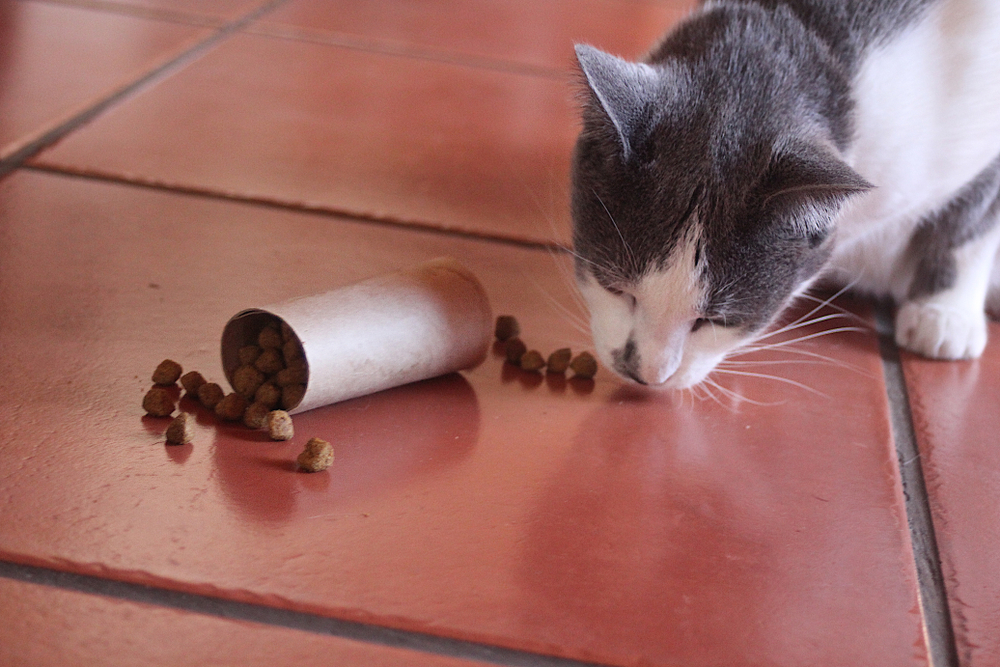Cat owners frequently regard their pets as easy or low maintenance pets, but this falsehood fails to consider that indoor cats lead an unnatural, different lifestyle, compared with their feral cousins. While indoor cats’ lives are certainly safer, their lifestyle restricts and limits their natural behavior, and affects their physical, emotional, and mental wellbeing.
By providing your cat with the strategic enrichment described in this Oliver Animal Hospital guide, you can improve your cat’s comfort, health, and quality of life.
What is feline enrichment?
Enrichment focuses on providing pets with choices, while meeting their environmental, social, and cognitive needs. Enrichment provides variety and consistency by creating a safe space where your cat’s basic needs (e.g., food, water, and shelter) are met, and they can engage in novel activities and their fulfill instinctive behaviors (e.g., predatory behavior, play, and social engagement).
Why are the basics not enough for your cat?
While cats are often given their basic necessities, they rarely have the opportunity to perform natural, instinctive behaviors, which can compromise their physical and emotional health. Cats often demonstrate lack of stimulation through:
- Urinary disorders
- Marking or spraying
- Obesity
- Repetitive grooming
What does feline enrichment entail?
Enrichment for your cat can be divided into four categories, or layers.
- The first layer = the feline environment — Cats are a territorial species, who consider their home their domain. Unless your cat goes outdoors, they spend 24 hours a day in the same unchanging territory. Add interest to each environmental element by using natural feline preferences as inspiration.
- Hiding — Cats do not like being exposed, and often hunt or observe their surroundings in seclusion. Arrange objects and furniture in your home so that your cat can hide. Cats are more secure and less prone to stress when they can sneak about, or quickly disappear.
- Climbing — Cats climb naturally, and prefer the safety and perspective of tall perches. Ensure your cat has several options (e.g., cat trees, stairs, or stable shelving or cabinets), with good footing and a safe way to get down.
- Scratching — Cats scratch to stretch, maintain their claws, and mark their territory. Redirect inappropriate scratching by providing vertical and horizontal scratching surfaces. Put some catnip on the post to initially attract your cat.
- Windows — Some cats may enjoy a good lookout, while others feel exposed or threatened. If your cat spends time by a window, make them a comfortable perch or window seat.
- The second layer = cat resources — Basic resources don’t have to be basic. Ensure your cat has choices for rest, food, water, and elimination.
- Rest — Beds should be elevated and warm. Place several beds in sunny, warm, quiet locations.
- Elimination — Encourage consistent litter box use by selecting a quiet location, removing soiled litter daily, and avoiding irritating liners and perfumed litter.
- Water — Bowls should be wide and full, so your cat does not need to bend, and their whiskers do not touch the sides.
- Food — A cat’s desire to hunt is not satisfied by eating on a schedule, from a bowl. Instead, try:
- Providing multiple feeding stations, located away from litter boxes
- Using various dishes, avoiding harmful plastic
- Hiding food to encourage hunting
- Presenting food in new ways (see Specific steps that will satisfy your cat)
- The third layer = social interaction among cats — While cats truly are solitary in nature, they require and desire healthy social interaction. Cats can benefit from the company of other cats, as long as resources and space are plentiful, to prevent bullying and competitive stress. Cats also benefit from regular human interaction, but on their own terms. Some cats adore physical contact, while others prefer to enjoy your presence from a safe distance. Respect your cat’s individual preferences, and provide reliable interaction in any form.
- fourth layer = cognitive enrichment for cats — Cats are attracted to new things, but they become bored quickly. Providing mental engagement for cats may test your patience and persistence because, like humans, they have individual tastes and preferences. Cognitive enrichment and play for cats are most effective when they simulate the predatory behavior cycle. A cat hunts prey in an instinctive sequence of searching, stalking, chasing, pouncing, catching, and manipulating.
Specific steps that will satisfy your cat

Incorporating some or all of the sequences, in order, will create a satisfying experience for your cat. Here are some ideas:
- If your cat likes food — Let them hunt for their meals. Hide food in puzzle toys that encourage reaching, foraging, and critical thinking. Smear wet food on lickable mats that you hide in unusual locations. Use moving dispensers to activate chasing and pouncing.
- If your cat likes toys or motion — Try toys with erratic motion, feather wands, and games of fetch. Remove the toys after play time so they do not lose their appeal. For more suggestions, check out this guide to playing with your cat.
- If your cat has reduced mobility — Let your injured or senior cat have fun with a catnip scented or stuffed toy, a lickable treat mat, or a cat television.
Healthy, happy, satisfied cats are no accident. By applying natural feline behaviors and instincts to their safe, secure indoor environment, you can ensure your cat has a long and fulfilling life. To schedule an appointment for your cat, or to learn out more about feline enrichment, contact our Oliver Animal Hospital team.







Leave A Comment